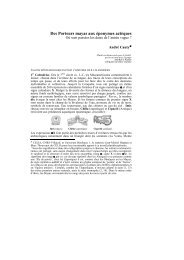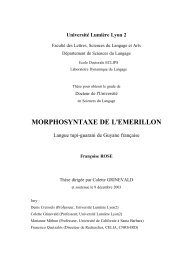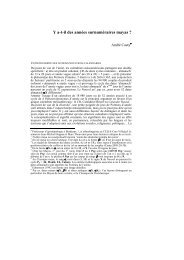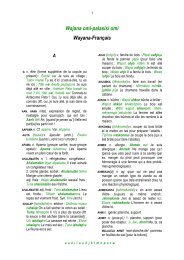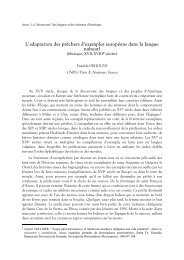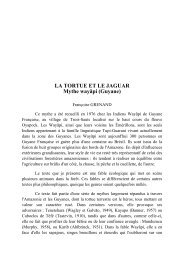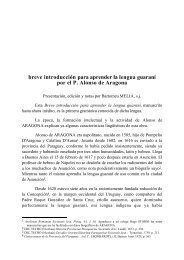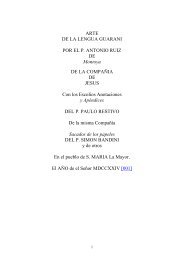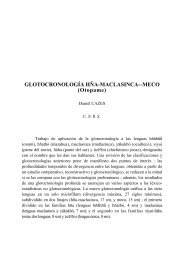The Blue Bird of Ergativity - celia
The Blue Bird of Ergativity - celia
The Blue Bird of Ergativity - celia
Create successful ePaper yourself
Turn your PDF publications into a flip-book with our unique Google optimized e-Paper software.
<strong>The</strong> <strong>Blue</strong> <strong>Bird</strong> <strong>of</strong> <strong>Ergativity</strong>Scott DELANCEYUniversity <strong>of</strong> Oregon<strong>The</strong> ergativity industry in modern linguistics was created during the 1970's,taking <strong>of</strong>f from Dixon's description <strong>of</strong> Dyirbal (1972), and established as a majorarea <strong>of</strong> research and theorizing by two survey articles at the end <strong>of</strong> the decade(Comrie 1978, Dixon 1979). During the 1970's the concept was primarily aplaything <strong>of</strong> the functional-typological school and <strong>of</strong> Relational Grammar, but formany years now the "problem <strong>of</strong> ergativity" has become a concern <strong>of</strong> syntacticians<strong>of</strong> all persuasions. My purpose here is to pose the question <strong>of</strong> whether there isactually a coherent, typologically and theoretically interesting phenomenon <strong>of</strong>"ergativity" which merits all <strong>of</strong> the attention given to it (for example in numerousconferences and workshops, such as this one, devoted to "ergativity in X"), and, ifthere might be, whether it can possibly subsume all <strong>of</strong> the different linguisticphenomena which are routinely adduced as examples <strong>of</strong> it.<strong>The</strong> question is, when we have a workshop on "ergativity" in variouslanguages, are we pursuing a coherent typological phenomenon, or just collectingspecimens? Not that there is anything wrong with collecting and comparingspecimens -- basic description <strong>of</strong> as wide as possible a range <strong>of</strong> languages andlinguistic phenomena is the bedrock foundation <strong>of</strong> any worthwhile work inlinguistics, and, as we all know, has been irresponsibly and shamefully neglectedand undervalued in the field over the last generation. But when we limit a collectionto certain kinds <strong>of</strong> specimens, there is a question whether a workshop on1
"ergativity" is analogous to an effort to collect, say, birds with talons -- animportant taxonomic criterion --, birds that swim -- which is taxonomically onlymarginally relevant, but a very significant functional pattern --, or, say, birds thatare blue, which will turn out to be pretty much a useless criterion for any biologicalpurpose.I would expect, for example, that a series <strong>of</strong> workshops on something like"subject" in Amazonian -- or Northwest North American, or South Asian, or whathave you -- languages would be very likely to have theoretically interesting results.But if I think about what might result from a workshop on "ergativity" in NorthwestNorth America, I suspect that we would end up with a kind <strong>of</strong> a natural historyexhibit, with various strange and exotic specimens on display, but no systematicresult issuing from it all. Now a workshop on ergativity in north India would bequite productive -- but that is because all the languages involved are geneticallyrelated and have some variant on the same kind <strong>of</strong> "ergativity", with the sameorigins. A workshop on ergativity in Himalayan languages might be <strong>of</strong> interest, butwhat we would find is several different patterns, with overlapping origins, eachreplicated with different variations in different languages. But what might come out<strong>of</strong> such a workshop would not be anything that could be usefully integrated withthe outcome <strong>of</strong> the North Indian workshop, and might or might not show somepatterns in common with what turned up in North America.What do we mean by ergativity?Dixon provides a version <strong>of</strong> the standard definition <strong>of</strong> "ergativity":a grammatical pattern in which the subject <strong>of</strong> an intransitive clause is treated in the sameway as the object <strong>of</strong> a transitive clause, and differently from transitive subject. (Dixon1994:1)which we might schematize as S = O ≠ A. Now, to start with, this phrasing is a bitout <strong>of</strong> touch with ordinary usage. <strong>Ergativity</strong> is generally talked <strong>of</strong> as being aboutmarking, or marked treatment, <strong>of</strong> the transitive subject, not about the "treatment" <strong>of</strong>the intransitive subject. But, leaving aside the question <strong>of</strong> phrasing, the definition isstill problematic. If this were actually the definition which we used, it might bemore useful than the "ordinary language" use (or might not, that is an empiricalquestion). But, although this definition is still <strong>of</strong>ten cited, I do not think anyonewould seriously hold to it in dealing with data like these, from Tibetan:1) kho-s blo=bzang-la gzhus-songhe-ERG Lobsang-LOC hit-PERFHe hit Lobsang.'2
what we mean by unmarked. I suppose we might agree that in the technical sense <strong>of</strong>"marked" -- i.e. where it does not necessarily refer to an actual mark -- the O thatdoes not have an actual mark is the unmarked term in the differential object pattern(although according to Hopper and Thompson's (1980) concept <strong>of</strong> transitivity thatwould not be the case), but it would be a bit more difficult to make that argumentfor Tibetan, where the case marking or lack <strong>of</strong> it on an O argument directly marksunderlying semantic role (DeLancey 2001). In fact what we would really want tomean is unmarked, in the sense <strong>of</strong> not having case marking, because that is actuallywhat we mean when we say ergative -- that there is special marking on the Aargument, which distinguishes it from S, which (almost always) has no overtmarking. <strong>The</strong> notion <strong>of</strong> ergativity is the idea that all languages, or at least allconstructions, which manifest this feature belong to a type. Obviously, strictlyspeaking this is true, in the sense that any feature defines a set. <strong>The</strong> question is, isthe set <strong>of</strong> all languages which are "ergative" in this sense an interesting ortypologically/theoretically useful one? In other words, do they have anything incommon besides this superficial feature?<strong>The</strong> concept <strong>of</strong> ergativity traces back to the observation (or "discovery",after the Columbus model) by Hugo Schuchardt (1895) <strong>of</strong> ergative patterns inCaucasian languages, and later in Basque. But its status as a major construct intypology and linguistic theory dates back only to the 1970's, when the phenomenonwas brought to general attention by Dixon, Silverstein, Comrie and others. Butfrom the outset <strong>of</strong> the ergativity explosion, it was evident that what had beenbrought to the public eye was not a phenomenon, but a cluster <strong>of</strong> phenomena whichneeded to be defined. However, this task <strong>of</strong> defining the object <strong>of</strong> study was neverseriously undertaken -- I remember very little serious discussion about includingthe two or three recognized types <strong>of</strong> split ergativity under the general rubric <strong>of</strong>ergativity. (Notice how much is assumed by the locution "split ergativity" -- what isour basis for assuming that "split ergativity" is a single coherent phenomenon <strong>of</strong>which there are subtypes?) <strong>The</strong>re was, however, considerable discussion aboutactive-stative typology, which was widely (though, if I may say so, absurdly) listedas one more subtype <strong>of</strong> split ergativity well into the 1980's (and is still so treated inDixon 1994). That is, the unity <strong>of</strong> several quite disparate and distinct linguisticpatterns was simply assumed from the outset, and continues to be: when typologiststalk about "alignments", there are typically only three listed: nominative-accusative,ergative-absolutive, and active-stative. Recent suggestions have proposedconsidering inverse-marking languages to represent a fourth "alignment", but I donot know <strong>of</strong> anyone who has suggested breaking up the "ergative" bloc -- althoughI demonstrated 25 years ago (at least to my own satisfaction) that the person-based4
"split ergative" pattern is probably better thought <strong>of</strong> as a variant <strong>of</strong> the inverse typethan <strong>of</strong> the ergative type (DeLancey 1981). (One aim <strong>of</strong> that paper was todemonstrate an underlying functional/cognitive unity to the superficially disparateaspect-based and person-based ergative "splits", but in retrospect I would say that,if the paper still has any value today, it is not that).Why we believe in ergativityWe have always, at some uncritical, pretheoretical level (and, most <strong>of</strong> thetime, in a very explicit theoretical sense), believed in the universality <strong>of</strong> Subject, inat least in Aristotelian sense. And for the most part we have not clearlydistinguished between that and believing in Subject and Object in the sense thatthey exist in Latin or English. We have always taken subject-formation, which wemay as well label "nominativity", to be the natural behavior <strong>of</strong> languages, so thatany language which does not immediately and obviously deviate from this patternis automatically considered to belong to it. <strong>The</strong>re are many languages which wouldstill be generally analyzed as "nominative" which in fact seem to be organized onquite different principles -- especially what Li and Thompson (1976) have called"topic-prominent" languages like Chinese, and, even more, certain peculiarvariations on that pattern such as Burmese. Chinese and similar languages have nosurface indication <strong>of</strong> case at all, and therefore no immediately evident reason toconsider them actively different from Latin or English; Burmese has distinctsubject- and object-marking postpositions, but uses them primarily to markdiscourse-pragmatically marked arguments (see e.g. Soe 1999).Thus, when we encountered languages which are immediately obviouslyorganized on different principles -- Basque, Georgian, Tibetan -- we had torecognize that there is another pattern, but, in good old-fashioned Europeandualistic thinking, that implies one other pattern, in opposition to the "natural"pattern that we are used to. As linguists slowly came to recognize the fundamentaldistinctness <strong>of</strong> the "active/stative" or "split-S" pattern <strong>of</strong> clause organization, wegrudgingly allowed for one more type, although, as we have noted, back in the1970's when these languages first started attracting the attention <strong>of</strong> typologists andtheoreticians, there was considerable debate here and there about whether theseshould be considered a distinct type, or some sort <strong>of</strong> weird subtype <strong>of</strong> ergativity,and even now the distinctness <strong>of</strong> "split-S" typology is not universally recognized.But this was as far as anyone wanted to go; when we had to deal with the likes <strong>of</strong>Hindi and Kiranti, rather than recognizing further new types, these were clearlyconsidered subtypes <strong>of</strong> ergative -- "split" ergative. Notice the presumption <strong>of</strong>5
elative markedness in this terminology -- some <strong>of</strong> us even at the time noted that alanguage like Hindi could just as well be called "split nominative" as "splitergative", but because it manifests, even in just one construction, the weird deviantpattern <strong>of</strong> "ergativity", it becomes "split ergative".It is very telling that we talk about "ergativity" -- and have conferences andworkshops on topics like "<strong>Ergativity</strong> in Amazonian Languages" -- but conferencesor thematic volumes devoted to "accusativity" or "nominativity" (which I think isthe preferable term) seem to be a less prominent feature <strong>of</strong> the linguistic landscape.I would suggest that we have this exactly backwards -- nominativity is an actualphenomenon, something which we could usefully talk about as a unifiedphenomenon. "<strong>Ergativity</strong>" is just bits and pieces <strong>of</strong> what is left over. Our traditioninclines us to think <strong>of</strong> "ergativity" as some special deviation from the norm; in factit is a non-category, it is simply the absence <strong>of</strong> nominativity.S, A, and ODixon's formulation <strong>of</strong> S, A and O, the "universal syntactic-semanticprimitives", is based directly on the myth <strong>of</strong> ergativity as one <strong>of</strong> just two basic"alignments". This way <strong>of</strong> thinking <strong>of</strong> things would not occur to us if we only hadnominative languages to look at; for those Subject and Object are sufficient. <strong>The</strong>distinction <strong>of</strong> A from O is a direct reflection <strong>of</strong> the idea (probably traceable to Sapir1917) <strong>of</strong> ergativity as sort <strong>of</strong> a complement to nominativity, where there are exactlytwo possibilities -- the single argument <strong>of</strong> an intransitive can pattern with one or theother <strong>of</strong> the arguments <strong>of</strong> a transitive clause. Of course we know that thetypological facts are not that simple; dative subject constructions and various kinds<strong>of</strong> "split accusativity" are awkward, the scheme leaves no place for "indirectobjects", which are a salient part <strong>of</strong> the syntactic organization <strong>of</strong> many languages,and no sensible way <strong>of</strong> talking about the "primary object" (Dryer 1986) pattern.And most devastatingly, as Mithun and Chafe (1999) have pointed out, the patternwhich is tendentiously called "split-S" by many scholars -- especially the versionwith 3-way splits, as in languages such as Choctaw -- pretty much vitiates thewhole idea <strong>of</strong> S as a "primitive". (In any case, as Dixon describes A, S, and O, theyare not semantic primitives, as they are based in semantic notions <strong>of</strong> control andactivity). <strong>The</strong> reason why we still cling to S, A and O as though they had somemeaning is because they derive neatly from the idea <strong>of</strong> European-style nominativityas the way languages are, with ergativity as its mirror image. Patterns which do notfit into this neat scheme are treated as derivative subcategories (note that Dixon still6
treats active-stative typology as a species <strong>of</strong> "split" ergativity (1994:70ff.)). I willreturn to the question <strong>of</strong> S, A and O below.Some ErgativitiesIf we are debating the question <strong>of</strong> what "ergativity" might be, we have tostart by looking at some ergative, or putatively ergative, languages to see what theymight have in common. Let us begin with two Tibeto-Burman languages, Mizo(also known as Lushei), <strong>of</strong> the Kuki-Chin branch <strong>of</strong> Tibeto-Burman, spoken inMizoram State in India and adjoining parts <strong>of</strong> Burma, and Tibetan, a language <strong>of</strong>the Bodic branch <strong>of</strong> the family.Mizo (Chhangte 1993) has a case postposition in which occurs always andonly on A arguments, in the classic ergative pattern:7) ka-nââw â-tap1sg-baby 3sg-cry'My baby is crying.'8) kâ-nùù-in â-kow-cê1sg-mother-ERG 3sg-call-2obj'My mother is calling you.'9) úy â - zuangdog 3sg - jump'A dog is jumping.'10) úy-in mìì â-se/dog ERG man 3sg-bite'A dog bit a man.'Notice two essential facts. First, there is consistent ergative case marking --all transitive A arguments, in all tenses and aspects, are marked with thepostposition in. <strong>The</strong>re is no case marking <strong>of</strong> S or, usually, O arguments. Thisappears to be as straightforward an ergative system as one could find. But noticealso that that the agreement clitics which precede the verb follow a consistentlynominative pattern: all <strong>of</strong> (7-10) 3 rd person proclitic â-, which always agrees with asubject argument. <strong>The</strong>re is one deviation from this consistent pattern, however: firstperson objects are indexed (with a special form) in preference to second or thirdperson subjects:11) ui in mi = se/dog ERG 1stOBJ = bite7
'A dog bit me.'In this language, I would argue, the case marking and agreement systemsfunction purely to mark grammatical relations, with no particular cognitivemotivation. <strong>The</strong> Mizo system nicely illustrates Givón's functional characterization<strong>of</strong> ergativity:<strong>The</strong> ergative-absolutive system ... is, first and foremost, a system wherecase-marking does the syntactic distinction between transitive and intransitiveclauses. (Givón 2001:208)But maybe we do want to insist that in marks some category. In thislanguage, that category is "A", pretty much just as Dixon defines it. We will returnlater to the question <strong>of</strong> what "A" might be.Like Mizo, Tibetan has a case postposition which occurs with A arguments,and thus must be labelled "ergative". (<strong>The</strong> data discussed here represent the Lhasadialect <strong>of</strong> Central Tibetan; it is not clear how much variation there may be acrossdialects in the details <strong>of</strong> the distribution <strong>of</strong> ergative marking). However, itsdistribution and function are entirely different from that <strong>of</strong> Mizo in. In the past(1984, 1985a, 1990) I have presented a simplified picture <strong>of</strong> Tibetan ergativity, asfollows. Ergative marking is obligatory on the A argument <strong>of</strong> a perfective transitiveclause, but optional in non-perfective tense/aspects:12) nga-s stag bsad-pa yinI-ERG tiger killed-PERF/CONJ'I killed a tiger.'13) nga(-s) stag gsod-kyi yod'I am killing a tiger.'14) nga(-s) stag gsod-kyi yin'I will kill a tiger.'It also occurs optionally on S arguments in perfective intransitive clauseswhich refer to intentional action, but never in non-perfective one-argument clausesor in non-control clauses:15) nga(-s) bod-la phyin-ba yinI(-ERG) Tibet-LOC went-PERF/CONJ'I went to Tibet.'16) nga(*-s) bod-la >gro-gyi yod8
But there is a basic problem which this characterization fails to address.Where I have characterized ergative marking as "optional", it serves a discoursepragmaticfunction, serving to place the argument which it marks in focus(Tournadre 1991, 1996). In other words, while its distribution is sensitive totransitivity, in any sense <strong>of</strong> that word, it simply cannot be interpreted as serving todistinguish transitive from intransitive clauses, which in fact it does not consistentlydo. <strong>The</strong> primary function <strong>of</strong> ergative marking seems to be to mark a discoursepragmatic,rather than a semantic or syntactic, category. This places the function <strong>of</strong>ergative marking in Tibetan in stark contrast to that in Mizo, where it is simplyalways present under appropriate syntactic conditions.It is likely that the ergative constructions in Tibetan and Mizo have similardiachronic origins. But, synchronically, the functions <strong>of</strong> the ergative in the twolanguages have virtually nothing to do with one another -- one serves to indicategrammatical relations, the other to mark a particular discourse-pragmatic category.<strong>The</strong>re is no point in considering them to be examples <strong>of</strong> the same linguistic type. Infact, Tibetan is much more usefully compared with "nominative" languages inwhich case marking serves a similar pragmatic function, such as Burmese (So1999) or Meithei (Chelliah 1997).Deictic categories: Person-based "split ergativity"Besides languages like Hindi, which show ergative marking in sometense/aspect constructions and nominative patterns in others, there is another wellknown"split" ergative pattern in which 3 rd person A arguments take transitivemarking, while 1 st and 2 nd A's do not. In DeLancey 1981 I argued that this kind <strong>of</strong>system is a direct grammatical reflection <strong>of</strong> the category <strong>of</strong> deixis, and is moreappropriately analyzed as a version <strong>of</strong> inverse marking than as anything related tocanonical ergativity. A few years after the publication <strong>of</strong> that paper, I was madeaware (originally by Noel Rude) <strong>of</strong> a language in which the deictic basis for "splitergative" marking is even clearer and more explicit than in the languages I hadexamined previously. This is Sahaptin, which with Nez Perce is one <strong>of</strong> the twoSahaptian languages <strong>of</strong> Oregon, Washington, and Idaho. (Sahaptian is part <strong>of</strong> thePlateau Penutian family. For further information on the language see Rigsby andRude 1996; see also Zúñiga 2003 for an analysis along the lines suggested here).In (21) and (22) we see that Sahaptin has a suffix, -in, which markstransitive A but not intransitive S:21) iwinsh i-winá-na '<strong>The</strong> man went'10
25) iwínsh-ni,-m=nam i-q'ínu-sha (ima-náy)man-ERG2=2sg 3Subj-see-PROG (you-OBJ)'<strong>The</strong> man sees you.'This fact by itself points up the centrality <strong>of</strong> deixis to the system, and thefundamentally deictic basis <strong>of</strong> the system is further attested in the apparent origin <strong>of</strong>the Sahaptin inverse ergative morpheme in an old cislocative form (Rude 1991).And the evidence for the grammatical prominence <strong>of</strong> the deictic center doesnot stop here. Phonologically independent 1 st and 2 nd person pronouns such as ínand ináy in the preceding examples occur only in emphatic or contrastivefunction. Ordinary 1 st and 2 nd person reference is accomplished by obligatorypronominal clitics, which occur cliticized to the first word <strong>of</strong> the sentence. <strong>The</strong>seclitic pronouns are not marked for case:26) á-q'inu-sha=ash iwinsh-na3Obj-see-PROG=1st man-OBJ'I see the man.'27) i-q'inu-sha=ash iwinsh-nim3Subj-see-PROG=1st man-ERG'<strong>The</strong> man sees me.'<strong>The</strong>y occur even in the presence <strong>of</strong> independent pronouns (see also ex. 23):28) ín=ash á-tuXnana yáamash-naI-1sg 3Obj-shot deer-OBJ'I shot a deer.'And they occur indexing SAP possessors <strong>of</strong> arguments:29) nishá-pa=sh wá kusikusihouse-in=1st be dog'My dog is in the house.'30) Xlák=nash wá núsuXlots=1sg be salmon'I have lots <strong>of</strong> salmon.' (lit. something like 'Me, there's lots <strong>of</strong> salmon')To summarize this picture, Sahaptin has invariable 1 st and 2 nd personpronominal forms which must be present in any clause which makes reference to a1 st or 2 nd person. Put otherwise, the language has forms whose only function isobligatory reference to the participants at the deictic center. Combined with the12
emarkably deictic system <strong>of</strong> ergative marking, this shows the central place <strong>of</strong> thedeictic center in Sahaptin morphosyntax.Now, to bring this discussion back to our main thread <strong>of</strong> argument, we cansee that the function <strong>of</strong> "ergativity" in Sahaptin is completely unrelated to that <strong>of</strong>what we called "ergativity" in either Tibetan or Mizo, and that in fact thesephenomena have hardly anything in common structurally either -- which leaves uswith the question <strong>of</strong> what use is a word, and more to the point, what use is aconcept, which tries to subsume them both as examples <strong>of</strong> a single category?Deictic marking in Kuki-ChinIn several languages <strong>of</strong> the Kuki-Chin branch <strong>of</strong> Tibeto-Burman (to whichMizo also belongs), a simple inverse marking system has developed from themarking <strong>of</strong> deictic orientation on motion verbs (DeLancey 1980). In theselanguages a motion verb *hong 'come' has become partially or completelygrammaticalized as a cislocative 'hither' prefix on motion verbs (see DeLancey1985b for details). In some languages this morpheme has developed the additionalfunction <strong>of</strong> optionally marking some transitive or ditransitive configurations with1 st or 2 nd person object. In Sizang (Stern 1963) we find the cislocative marker usedat least optionally with any transitive or ditransitive verb with 1st or 2nd personobject or goal, as in (exx. from Stern 1984:52, 56):31) na-lá:i hong thák ka-ngá: a:2nd-letter CIS send 1st-receive NF'I having received your letter which [you] sent to me ...'32) k-ong thûk kí:k lâ-lê:u hî:1st-CIS reply again once more FIN'... I in turn reply to you.'33) hong sá:t thê:i lê:CIS beat ever INTER'Do [they] ever beat you?'34) hong sá:t lé: ká-pe:ng tál dong ká-ta:i tû:CIS beat if 1st-leg break until 1st-flee FUT'If [they] beat me I'll run till my legs break.'(Note that (31) has an easily recoverable 2nd person subject which howeveris not indexed in the verb, and both (33) and (34) have a specific anaphoric thirdperson plural subject, the second speaker's parents, which is explicitly mentioned in13
a full NP two clauses previous to these; these are thus not indefinite subject"agentless" passives). <strong>The</strong> (h)ong in all <strong>of</strong> these examples occurs when there is a 1 stor 2 nd person goal or object, even when, as in exx. 31 and 32, the subject is theother Speech Act Participant. In Sizang-Tiddim, as in Mizo, personal indexation inthe transitive verb is consistently with the subject rather than with the principalparticipant.<strong>The</strong> point which I want to call attention to here is the parallel between thedistribution <strong>of</strong> the verbal proclitic hong in Sizang and Tiddim and the deictic"ergative" suffix -ni,-m in Sahaptin -- which is less than surprising given that bothoriginate in a spatial cislocative. But since Sahaptin -ni,-m suffixes to an Aargument, we will inevitably call it "ergative", while hong, which is a verbal affix,would never be called any such thing. So the question is, what is the concept <strong>of</strong>"ergativity" doing for us here, if it simply obscures the strong functional parallelbetween the two constructions? Especially since Kuki-Chin languages are ergative,in the classic sense, as we have already seen in the Mizo data. So, if Sahaptin -ni,-mmarks the same functional domain as K-C hong , then it does not mark the samedomain as the K-C ergative postposition in. So whatever "ergativity" is, they can'tboth be ergative.And, just to avoid another possible confusion, let me point out that a system<strong>of</strong> deictic marking exactly like that in Sizang is also found in two Dravidianlanguages, Kui (Winfield 1929) and Pengo (Burrow and Bhattacharya 1970), whichare uncompromisingly non-ergative in their morphology; and that we can seesomething quite similar in languages <strong>of</strong> the non-ergative Loloish branch <strong>of</strong> Tibeto-Burman (see Matis<strong>of</strong>f 1982:325-6).What are the primes? S, A and O once moreAs I have already pointed out, the notion <strong>of</strong> ergativity is usually defined interms <strong>of</strong> S, A and O. Since the S/A/O schema derives directly from the concept <strong>of</strong>ergativity, and the idea that ergative and nominative between them essentiallydefine the range <strong>of</strong> "alignment" possibilities, there is a certain circularity in such adefinition, but the definition would be legitimized if we had an indepent definition<strong>of</strong> the "primes". But, if S, A and O are real categories <strong>of</strong> language, what exactly arethey? <strong>The</strong> concept <strong>of</strong> ergativity more-or-less assumes that the A category has somesort <strong>of</strong> content, like Agent or Topic or (even) Subject. But what would that contentbe?14
<strong>The</strong>re are some categories, which at this level <strong>of</strong> discussion we can take asprimitives, which we can define and specifiy the content <strong>of</strong>. <strong>The</strong>re is generalagreement on semantic roles (if not necessarily on a specific set <strong>of</strong> them), inparticular Agent, which in some sense are certainly real, and pragmatic categorieslike topic and focus, which likewise are certainly real, even if we don't reallyunderstand yet what they are. Subject is trickier; the tradition over the lastgeneration <strong>of</strong> seeing it as some kind <strong>of</strong> intersection or amalgam <strong>of</strong> Agent and Topicgives it some real content, but leaks terribly. I think, though, that, followingresearch by Tomlin and others, we can define subject quite neatly in terms <strong>of</strong> thepsychologically unassailable category <strong>of</strong> attentional focus. In spite <strong>of</strong> Dixon'sadmirable efforts in that direction, as far as I can see S, A and O cannot be givencontentful definitions <strong>of</strong> this type.S, A and O are useful etic concepts. Assuming that every language hasintransitive clauses, it follows that S is certainly a descriptive universal. However,the abundant evidence from so-called "Split-S" languages makes it evident that it isno more than that -- there is no universal unitary S category. In fact, as far as I cansee, there is no emic S category in any language. An emic category -- that is, acategory which is actually part <strong>of</strong> the grammar <strong>of</strong> a language -- must be definableby either structural or functional criteria -- ideally both, <strong>of</strong> course, but let us agreethat for now we will settle for one or the other. Of course, in a two-way split Slanguage like Lakhota or Pomo, and even moreso in a three-way split S languagelike Choctaw-Chickasaw, there is no S category whatever. In nominative languages,S arguments are subjects, just as A arguments are, but in a language like Englishthere is no S category apart from Subject -- that is, there are no structural orsemantic/pragmatic criteria by which one can identify intransitive subjects as adistinct subcategory <strong>of</strong> subject. One might argue that in a prototypical ergativeabsolutivelanguage we could define an S category in structural terms as thatargument which shares its morphological properties with O and its syntacticproperties with A, and that might be enough to satisfy us that we have a distinctcategory -- but clearly not a universal one.A and O are a bit more challenging. Assuming that all languages havetransitive clauses, then in any language there will be two kinds <strong>of</strong> transitiveargument. Referring to these by putatively universal labels like Subject and Objector A and O makes the claim -- explicitly asserted by Dixon (1994) -- that everylanguage will identify the same two categories <strong>of</strong> argument within the transitiveclause. <strong>The</strong> essential phenomenon which we need to deal with is that languagesstrongly tend to treat experiencers and agents as a natural class (DeLancey 1996).15
Even in a consistent dative-subject type language (e.g. Malayalam, Mohanan andMohanan 1990), where we could argue that surface marking <strong>of</strong> arguments fails torecognize the A category, we typically find that syntactic phenomena treat agentsand experiencers alike, as opposed to the "undergoer" roles that typically form Oarguments. For Dixon, this can be explained in terms <strong>of</strong> the fact that typicalexperiencers are the same kinds <strong>of</strong> entities as typical agents, so that, <strong>of</strong> the twoarguments <strong>of</strong> a transitive verb, the A will be "that semantic role which couldexercise control, if anything could" (1994:31), that is, "that role which is mostlikely to be relevant to the success <strong>of</strong> the activity" (1994:52).However, we do not actually have here evidence <strong>of</strong> the A category behavingas a natural class. In any language in which agent and experiencer arguments <strong>of</strong>transitive verbs behave alike with respect to syntactic processes, it is also the casethat S arguments also show the same behavior. That is, once again we are looking ata subject category, with no particular reason to subdivide it into A and S primitives.For Dixon, Subject is a derived category, representing the union <strong>of</strong> A and S, andcan be defined semantically, as both A and S "refer to functions that can beinitiating/controlling agents" (1994:125). I think this is a hopeless enterprise -- thesubject category, which unites agents, experiencers, possessors, located <strong>The</strong>mes andall other S arguments, cannot be defined semantically. It is a pragmatic category,best identified with the psychological notion <strong>of</strong> attentional focus (Tomlin 1997,Forrest 1999, DeLancey 2001). Attentional focus is indeed a prime, though it doesnot receive the same kind <strong>of</strong> grammatical attention in all languages.Now, S, A and O are useful etic, which is to say, descriptive, categories,and in a way which reinforces what I have been saying. What does it mean to callthem "descriptive"? For example, recall my thumbnail description <strong>of</strong> Tibetanabove. In trying to quickly give another linguist an idea <strong>of</strong> what Tibetan is like, theterms A, S and O are very useful signposts. So, I could describe Tibetan as havingdifferential marking on the A according to a complex mix <strong>of</strong> agentivity, aspect, anddiscourse-pragmatic factors, and differential marking on S according to a slightlydifferent mix <strong>of</strong> the same set <strong>of</strong> factors, and marked or unmarked O according to astrict semantic-syntactic factor. Now, a believer in these "syntactic-semanticprimes" might say, OK, notice that you describe A as being differentially markedaccording to a deictic hierarchy, and O as differentially marked according to thesemantics <strong>of</strong> the verb -- but does not that description presuppose underlying A andO categories which can be differentially marked? No, in fact it does not. Tibetanhas a few dative-subject predicates:35 khong-la snyu=gu cig dgo=gi16
he-LOC pen a want-IMPF'He needs/wants a pen.'So ergative marking does not affect all A arguments, by Dixon's definition.Nor, as we have seen, does it affect only A arguments. Thus, it does not selectDixon's A as a class, and no other rule or pattern in the language does either. Butproblems with the A category are old news. More striking is the fact that, inTibetan, there is no emic object, or O, category -- that is, there is no rule whichaffects, or construction which involves, or however you want to put it, all and onlyO arguments. Most dramatically, as we have seen, O arguments are differentiallymarked according to the type <strong>of</strong> verb. That is, Tibetan provides exactly the samekind <strong>of</strong> evidence for distinguishing <strong>The</strong>me and Goal objects as Dyirbal does fordistinguishing A and S.What this means is that it is entirely possible to write a complete,comprehensive grammatical description <strong>of</strong> Tibetan and never mention the A or Ocategory. In fact, this is objectively the best way to describe the language; anyreference to an O or object category will only be for the purpose <strong>of</strong> making the facts<strong>of</strong> the language accessible to someone who is used to thinking in those terms. And,even if one should want to mention a category <strong>of</strong> transitive subject, or A, orsomething, that category does not correspond to Dixon's A, since it excludes some(but not all) experiencer subject clauses. And, since some intransitive arguments arezero-marked, others ergative marked, and a few dative-marked, there is nogrammatically distinct S category in the language. <strong>The</strong>se terms remain descriptivelyuseful only because they provide a terminology for laying out these facts in amanner that will be accessible to someone who is used to thinking in terms <strong>of</strong>subject and object, but they have no reality whatever within the language itself.What can we believe in??<strong>The</strong> term ergative has a well-established and necessary place in linguistics,as the name for a surface case category. Many languages have a case form whichoccurs only or primarily with the subject-like argument <strong>of</strong> a transitive clause, and indescribing such a language we need to call it something. It is also <strong>of</strong>ten useful torefer to ergative constructions, in languages where these contrast with nominativeconstructions. But the word ergativity implies something more, that languages withsuch a case form (or, perhaps, where such a case form occurs in the discoursepragmaticallyleast marked transitive clause pattern) have something more incommon. I do not see that there is very much evidence for any such thing. I thinkthat there is what we might call "nominativity", except that there are better ways to17
talk about it. That is, a great many languages are what Anderson (1979) callssubject-forming languages, and that is a very particular kind <strong>of</strong> grammaticalorganization. Now, it is not by any means obvious that all languages which lack any"ergative" marking are automatically subject-forming languages -- that may be true,but such a conclusion requires further research on inverse typology, Austronesianvoice systems, Li and Thompson's topic-prominent typology, and on the oddvariants <strong>of</strong> that (if that is what they are) in languages like Burmese and Meithei.But as for the many languages in the world which do not have a clearsubject category the way most European and many other languages do, we need torecognize that there are several different parameters which languages cangrammaticalize in their system <strong>of</strong> marking core arguments. Transitivity is one <strong>of</strong>these, as Givón points out, and, independently (more or less) <strong>of</strong> that, the Agentivitycomplex -- though it remains an open question whether we can speak <strong>of</strong> Agentivityas a primitive in this way, or whether it must be broken down into components <strong>of</strong>eventivity, control, volition, and what all. In any case it probably has to be keptseparate from general causation, which also has its effect in core argument marking.Another, which has been grossly neglected to date (though that is not MY fault) isdeixis, which, when it is recognized at all, tends to be carelessly and incorrectlylumped together with animacy -- which may also be a relevant factor, and, <strong>of</strong>course, points back towards control, and hence toward Agentivity.Now, languages grammaticalize many different combinations <strong>of</strong> these, inmany different ways, and the grammaticalization <strong>of</strong> the same parameter may beaccomplished in quite different ways, which may or may not involve case marking.For example, it might be useful to compare transitivity as reflected in Mizo ergativemarking with transitivity as reflected in the detransitivizing so-called "reflexive"constructions <strong>of</strong> most European languages. And it is a rather obvious idea (as Ipointed out many years ago) to compare the grammaticalization <strong>of</strong> deixis in "splitergative" languages and in inverse-type languages, which <strong>of</strong>ten show nomorphological features that we would be inclined to call ergative.My point, my final suggestion, is that being obsessed with the idea <strong>of</strong>"ergativity" actually pulls us away from these very promising lines <strong>of</strong> research, andleaves us comparing bluebirds and blue jays, for no better reason that they are sort<strong>of</strong> the same color.18
ReferencesANDERSON, John. 1979. On being without a subject. Bloomington: IndianaUniversity Linguistics Club.BOSSONG, Georg. 1985. Empirische Universalienforschung: DifferentielleObjektmarkierung in den neuiranischen Sprachen. Tübingen: Gunter Narr.BURROW, T., and S. BHATTACHARYA. 1970. <strong>The</strong> Pengo language. London:Oxford.CHELLIAH, Shobhana. 1997. A grammar <strong>of</strong> Meithei. Berlin: Mouton de Gruyter.COMRIE, Bernard. 1978. <strong>Ergativity</strong>. Pp. 329-94 in Winfred Lehmann, ed.,Syntactic Typology. Austin: University <strong>of</strong> Texas Press.1979. Definite and animate direct objects: A natural class. Linguistica Silesiana3.13-21.DELANCEY, Scott. 1980. Deictic categories in the Tibeto-Burman verb. Ph.Ddissertation, Indiana University.1981. An interpretation <strong>of</strong> split ergativity and related patterns. Language57.626-57.1984. Transitivity and ergative case in Lhasa Tibetan. Proceedings <strong>of</strong> the TenthAnnual Meeting <strong>of</strong> the Berkeley Linguistics Society, 131-40.1985a. On active typology and the nature <strong>of</strong> agentivity. Pp. 47-60 inFrans Plank, ed., Relational Typology. <strong>The</strong> Hague: Mouton.1985b. <strong>The</strong> analysis-synthesis-lexis cycle in Tibeto-Burman: A case study inmotivated change. Pp. 367-89 in John Haiman, ed., Iconicity in Syntax.Amsterdam and Philadelphia: Benjamins.1990. <strong>Ergativity</strong> and the cognitive model <strong>of</strong> event structure in Lhasa Tibetan.Cognitive Linguistics 1.3:289-321.1996. rev. <strong>of</strong> R.M.W. Dixon, <strong>Ergativity</strong>. Journal <strong>of</strong> Linguistics 32:173-177.2001. <strong>The</strong> universal basis <strong>of</strong> case. Logos and Language 1.2:1-15.DIXON, R.M.W. 1972. <strong>The</strong> Diyrbal language <strong>of</strong> North Queensland. Cambridge:Cambridge University Press.1979. <strong>Ergativity</strong>. Language 55.59-138.1994. <strong>Ergativity</strong>. Oxford: Oxford University Press.19
DRYER, Matthew. 1986. Primary object, secondary object, and antidative.Language 62.808-45.FORREST, Linda. 1999. <strong>The</strong> role <strong>of</strong> attention and activation in languageproduction: A neurocognitive linguistic approach. Ph.D. dissertation,University <strong>of</strong> Oregon.GIVÓN, T. 2001. Syntax: An introduction, Vol. 1. Amsterdam: Benjamins.HOPPER, Paul, and S. A. THOMPSON. 1980. Transitivity in grammar anddiscourse. Language 56.251-99.LI, Charles, and S. A. THOMPSON. 1976. Subject and topic: A new typology <strong>of</strong>language. Pp. 457-90 in Charles Li, ed., Subject and topic. New York:Academic Press.MATISOFF, James. 1972. <strong>The</strong> grammar <strong>of</strong> Lahu. Berkeley and Los Angeles:University <strong>of</strong> California Press.MITHUN, Marianne, and Wallace CHAFE. 1999. What are S, A and O? Studies inLanguage 23:3.569-606.MOHANAN, K.P., and Tara MOHANAN. 1990. Dative subjects in Malayalam:Semantic information in syntax. pp. 43-57 in Manindra Verma and K.P.Mohanan, eds. Experiencer Subjects in South Asian Languages. Stanford:Center for the Study <strong>of</strong> Language and Information.RIGSBY, Bruce, and Noel RUDE. 1996 Sketch <strong>of</strong> Sahaptin, a Sahaptian language.Pp. 666-692 in Ives Goddard, ed., Languages. (Handbook <strong>of</strong> North AmericanIndians vol. 17). Washington: Smithsonian Institution.RUDE, Noel. 1991. On the origin <strong>of</strong> the Nez Perce ergative NP suffix. IJAL57:24-50.SAPIR, Edward. 1917. Review <strong>of</strong> Uhlenbeck, "Het passieve karakSter van hetverbum transitivum <strong>of</strong> van het verbum actionis in talen van Noord-Amerika."IJAL 1.82-6.SCHUCHARDT, Hugo. 1895. Über den passiven Charakter des Transitivs in denkaukasischen Sprachen. in: Sitzungsberichte der kais. Akademie derWissenschaften, phil.-hist. Klasse, vol. 133. Vienna.20
SILVERSTEIN, Michael. 1976. Hierarchy <strong>of</strong> features and ergativity. Pp. 112-71 inR.M.W. Dixon, ed., Grammatical categories <strong>of</strong> Australian languages.Canberra: Australian Institute <strong>of</strong> Aboriginal Studies.SOE, Myint. 1999. A grammar <strong>of</strong> Burmese. Ph.D. dissertation, University <strong>of</strong>Oregon.STERN, <strong>The</strong>odore. 1963. A provisional sketch <strong>of</strong> Sizang Chin. Asia Major n.s.10.222-78.1984. Sizang (Siyin) Chin texts. Linguistics <strong>of</strong> the Tibeto-Burman Area8.1:43-58.TOMLIN, Russell. 1997. Mapping conceptual representations into linguisticrepresentations: <strong>The</strong> role <strong>of</strong> attention in grammar. in Jan Nuyts and EricPederson, eds., Language and conceptualization, pp. 162-89. Cambridge:Cambridge University Press.TOURNADRE, Nicolas. 1991. <strong>The</strong> rhetorical use <strong>of</strong> the Tibetan ergative.Linguistics <strong>of</strong> the Tibeto-Burman Area 14.93-108.1996. L'Ergativite en tibetain: approche morphosyntaxique de la langue parlee.Paris: Peeters.WINFIELD, W.W. 1929. A grammar <strong>of</strong> the Kui language. (Bibliotheca Indica no.245, issue n.s. no. 1496). Calcutta: Asiatic Society <strong>of</strong> Bengal.ZÚÑIGA, Fernando. 2003. Inverse systems in the indigenous languages <strong>of</strong> theAmericas. Ph.D. dissertation, Universität Zürich.21



